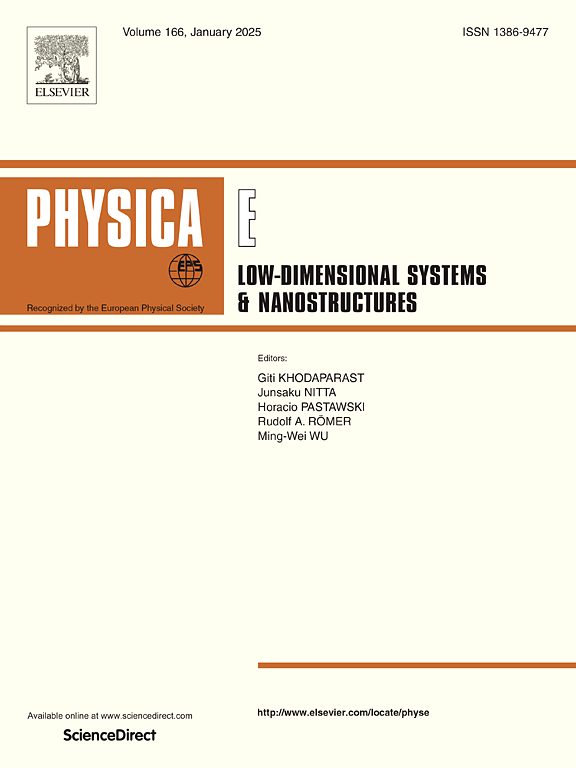具有强拉什巴和泽曼耦合的二维电子共振自旋动力学
IF 2.9
3区 物理与天体物理
Q3 NANOSCIENCE & NANOTECHNOLOGY
Physica E-low-dimensional Systems & Nanostructures
Pub Date : 2024-11-09
DOI:10.1016/j.physe.2024.116147
引用次数: 0
摘要
二维(2D)系统能够增强载流子的自旋轨道耦合并使之多样化,这是提高现代自旋电子器件电荷-自旋转换效率的关键因素。增加二维自旋相互作用还能改变二维材料的动态自旋相关特性,从而显示共振现象。在这项研究中,我们将重点放在电荷-自旋转换的动力学特性上,分析二维电子在强自旋轨道耦合和泽曼自旋分裂时的共振自旋动力学,这可能会超过电子的逆弛豫时间。我们从布洛赫动力学方程中推导出共振频率和弛豫速率,并研究了自旋感性极点的轨迹如何随着自旋分裂和弛豫时间的变化而变化,特别关注了相互竞争的拉什巴效应和泽曼效应之间的相互作用。本文章由计算机程序翻译,如有差异,请以英文原文为准。
Resonant spin dynamics of 2D electrons with strong Rashba and Zeeman couplings
Two-dimensional (2D) systems enable enhancing and diversifying the spin–orbit coupling of carriers, a key factor for better charge–spin conversion efficiencies in modern spintronic devices. Increasing 2D spin interactions also modifies dynamical spin-dependent properties of 2D materials, enabling to display resonant phenomena. In this work we focus on dynamical properties of the charge–spin conversion and analyze the resonant spin dynamics of 2D electrons upon strong spin–orbit coupling and Zeeman spin splittings, possibly exceeding the inverse relaxation times of electrons. We derive resonant frequencies and relaxation rates from the Bloch kinetic equations and examine how the trajectories of spin susceptibility poles change with variations in spin splittings and the relaxation time, paying special attention to the interplay between competing Rashba and Zeeman effect.
求助全文
通过发布文献求助,成功后即可免费获取论文全文。
去求助
来源期刊
CiteScore
7.30
自引率
6.10%
发文量
356
审稿时长
65 days
期刊介绍:
Physica E: Low-dimensional systems and nanostructures contains papers and invited review articles on the fundamental and applied aspects of physics in low-dimensional electron systems, in semiconductor heterostructures, oxide interfaces, quantum wells and superlattices, quantum wires and dots, novel quantum states of matter such as topological insulators, and Weyl semimetals.
Both theoretical and experimental contributions are invited. Topics suitable for publication in this journal include spin related phenomena, optical and transport properties, many-body effects, integer and fractional quantum Hall effects, quantum spin Hall effect, single electron effects and devices, Majorana fermions, and other novel phenomena.
Keywords:
• topological insulators/superconductors, majorana fermions, Wyel semimetals;
• quantum and neuromorphic computing/quantum information physics and devices based on low dimensional systems;
• layered superconductivity, low dimensional systems with superconducting proximity effect;
• 2D materials such as transition metal dichalcogenides;
• oxide heterostructures including ZnO, SrTiO3 etc;
• carbon nanostructures (graphene, carbon nanotubes, diamond NV center, etc.)
• quantum wells and superlattices;
• quantum Hall effect, quantum spin Hall effect, quantum anomalous Hall effect;
• optical- and phonons-related phenomena;
• magnetic-semiconductor structures;
• charge/spin-, magnon-, skyrmion-, Cooper pair- and majorana fermion- transport and tunneling;
• ultra-fast nonlinear optical phenomena;
• novel devices and applications (such as high performance sensor, solar cell, etc);
• novel growth and fabrication techniques for nanostructures

 求助内容:
求助内容: 应助结果提醒方式:
应助结果提醒方式:


